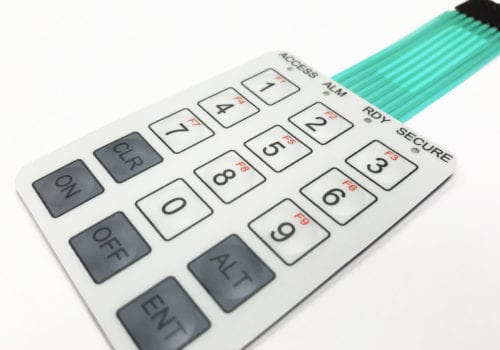Discover Different Kinds Of Membrane Switch Technologies for Your Needs
Discover Different Kinds Of Membrane Switch Technologies for Your Needs
Blog Article
How Membrane Layer Switches Add To the Durability of Electronic Control Panels
Membrane layer buttons play a crucial role in improving the toughness of electronic control panels, mostly via their multi-layered building which supplies effective protection versus ecological elements such as moisture and dirt. The lack of relocating parts significantly lowers the chance of mechanical failures, making membrane switches ideal for requiring applications.
Meaning of Membrane Layer Buttons

Membrane layer switches are made to be slim and lightweight, making them ideal for applications where area is limited. They can be produced in various shapes, sizes, and shades, supplying flexibility in design that meets aesthetic and practical demands. In addition, membrane layer buttons can include various innovations, such as responsive feedback and LED indicators, enhancing customer experience.
Because of their building and construction, membrane buttons are often immune to dirt, wetness, and basic wear, contributing to their durability popular atmospheres. Their seamless style not just assists in very easy cleansing but additionally lessens the danger of mechanical failing, making them a favored selection for makers looking for reputable interface in their digital control panels.
Defense Versus Ecological Variables
The layout of membrane changes naturally supplies a degree of protection versus numerous environmental elements, which is crucial for maintaining functionality in tough problems - Membrane Switch. These switches are commonly built with layers of versatile materials that shield inner elements from moisture, dirt, and impurities. By encapsulating the wiring, membrane layer changes minimize the danger of short circuits and corrosion, which can dramatically hinder performance
In addition, using robust adhesives and sealers throughout production improves their resistance to environmental obstacles. Membrane buttons can sustain direct exposure to chemicals and solvents, making them suitable for sectors such as food processing and health care, where health and tidiness are paramount. Their smooth surface style also prevents the build-up of dust and bacteria, promoting much easier cleaning and upkeep.
Temperature changes are another environmental problem, and membrane layer buttons are engineered to operate efficiently throughout a wide variety of temperatures (Membrane Switch). This versatility ensures that control panels continue to be functional in various settings, from industrial settings to consumer electronics
Influence On Customer Interaction
User interaction with electronic control board is dramatically affected by the design and performance of membrane layer switches. These switches offer a responsive user interface that boosts the total user experience, allowing for intuitive navigation and control. Their responsive nature makes certain that users get prompt feedback upon activation, which is important for jobs needing accuracy and performance.
Additionally, the smooth surface area of membrane layer switches over facilitates easy cleaning and maintenance, advertising individual self-confidence in the dependability of the interface. This sanitation is specifically important in atmospheres where health is vital, such as clinical or food processing settings. Furthermore, the portable and light-weight style of membrane switches contributes to the aesthetic allure of control panels, encouraging customer involvement via a contemporary and smooth look.
In addition, the assimilation of aesthetic aspects, such as published icons and backlighting, assists customers quickly determine functions, minimizing the finding out curve related to new tools. As an outcome, users can operate gadgets More about the author a lot more successfully, leading to increased efficiency and fulfillment. In summary, membrane layer buttons play a critical duty in boosting individual communication by integrating functionality, aesthetic appeals, and convenience of usage, ultimately causing enhanced functional effectiveness.
Layout Adaptability and Modification
Style flexibility and personalization are important facets of membrane buttons, allowing producers to customize electronic control panels to specific applications and individual requirements. This adaptability permits the assimilation of different layout aspects, such as shades, graphics, and structures, which can boost the visual charm and customer engagement of the control board.
Membrane buttons can be customized in shapes and size, accommodating a variety of gadgets and applications, from commercial machinery to consumer electronic devices. This adaptability ensures that suppliers can produce instinctive user interfaces that line up with individual expectations and operational demands. Additionally, the capacity to integrate one-of-a-kind attributes such as backlighting or responsive feedback additionally improves use, permitting an extra interactive experience.
In addition, the manufacturing procedure for membrane layer changes supports the quick prototyping of layouts, enabling suppliers to repeat and fine-tune their concepts quickly. This ability not only increases the growth timeline yet likewise ensures that the final product meets particular practical and aesthetic standards.

Cost-Effectiveness and Durability
Cost-effectiveness and durability are considerable benefits of membrane switches, making them an eye-catching option for suppliers and end-users alike. These switches are typically less costly to generate than standard mechanical switches, mainly due to their streamlined manufacturing processes and the lowered variety of components required. This cost advantage expands not only to initial manufacturing but additionally to long-lasting operational expenditures, as membrane buttons frequently require less maintenance and have a lower failure price.
In addition, the durability of membrane changes adds to their total worth. Constructed from sturdy materials, they are resistant to environmental variables such as dampness, dust, and chemicals, which can bring about premature wear in other switch types. The absence of moving components decreases mechanical failure, enabling membrane layer read more switches to preserve performance over extended durations.
This durability is specifically beneficial in applications needing constant performance under demanding conditions, such as clinical tools and commercial devices. Ultimately, the mix of cost-effectiveness and durability makes membrane switches an economically feasible choice for producers, providing trustworthy options that withstand the test of reference time while optimizing monetary considerations.
Final Thought
In conclusion, membrane layer buttons significantly enhance the longevity of digital control panels through their robust construction and safety attributes - Membrane Switch. In general, membrane switches represent a reliable and affordable selection for boosting the long life and capability of electronic control systems.
Report this page